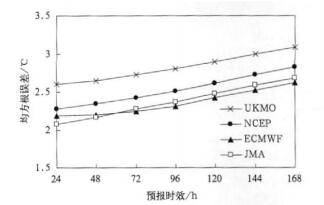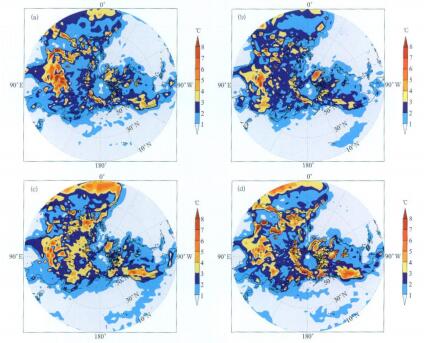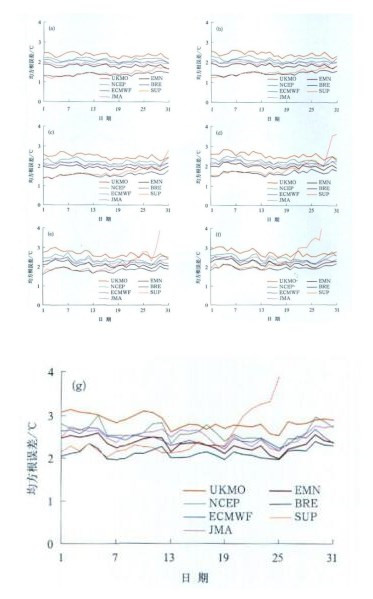基于TIGGE资料的地面气温多模式超级集合预报
Multi-model Superensemble Forecasts of the Surface Temperature Using the TIGGE Data
-
摘要: 基于TIGGE资料, 采用均方根误差分别对欧洲中期天气预报中心、日本气象厅、美国国家环境预报中心和英国气象局4个中心集合预报的地面气温场集合平均结果进行检验评估, 比较各中心地面气温的预报效果。并利用超级集合、多模式集合平均和消除偏差集合平均3种方法对4个中心的地面气温预报进行集成, 同时对预报结果进行分析。结果表明: 2007年夏季日本气象厅与欧洲中期天气预报中心在北半球大部分地区预报效果最好, 各中心在不同地区预报效果不同。超级集合与消除偏差集合平均降低了预报误差, 预报效果优于最好的单个中心预报和多模式集合平均。对于较长的预报时效, 消除偏差集合平均表现出了更好的预报性能。Abstract: Based on the TIGGE data, the ensemble mean outcomes of the 24-168 hours ensemble forecasts for the surface temperature in the Northern Hemisphere during the summer of 2007 are provided by ECMWF, JMA, NCEP and UKMO. Root-mean-square errors (RMSE) of the results are examined.The multi-model ensemble forecasts of the surface temperature for the forecast period from August 1 to 31 of 2007 are conducted by utilizing the superensemble, the multi-model ensemblemean, and the bias-removed ensemble mean.The forecast skills of these multi-model ensemble methods are investigated.The results show that the JMA model performs best for 24-hour and 48-hour forecasts, but for 72-hour to 168-hour forecasts the ECM WF model is the one with the highest skill. Forecast skills of these four models of different operational forecast centers are quite different over various regions.The JMA model performs best in the United States and Europe, while in China the UKMO model is the best one. Actually, none of the four models is perfect for all regions in the Northern Hemisphere.Therefore, it is necessary to utilize the multi-model superensemble methodology to improve the forecast skill.The multi-model superensemble and the bias-removed ensemble mean reduce the RMSE of the surface temperature forecast considerably.Both methods show an improvement on the forecast skill over the best single model forecast and the multimodel ensemblemean.In early (late) phase of the forecast period, the multi-model superensemble produces a smaller (larger) RMSE than the bias-removed ensemble mean for the 24-hour and 48-hour forecasts.For the 72-hour to 168-hour forecasts, both the multi-model superensemble and the the bias-removed ensemble mean lead to smaller RMSE than the multi-model ensemble mean and single models during the first two weeks of the forecast period.Never theless, two weeks later the RMSE of the superensemble forecast increases rapidly, and exceeds that of the bias-removed ensemble mean.The RMSE of the multi-model superensemble forecast may even exceed that of the single model forecast at the end of the forecast period.Weight coefficients of multi-model superensemble methodology remain unchanged during the fixed training period. It's expected that an improved multi-model superensemble methodology with flexible training period when statistical weights of the multi-models vary with time may further improve the forecast skill.
-
Key words:
- TIGGE;
- ensemble mean;
- superensemble;
- bias-removed ensemble mean
-
-
[1] Lorenz E N.A study of the predictability of 28-variable atmosphere model. Tellus, 1969, 21:739-759. [2] Leith C E. Theoretical skill of Monte Carlo forecasts. Mon Wea Rev, 1974, 102:409-418. doi: 10.1175/1520-0493(1974)102<0409:TSOMCF>2.0.CO;2 [3] Epstein E S. Stochastic dynamic prediction. Tellus, 1969, 21:739-759. http://journals.co-action.net/index.php/tellusa/article/view/10143 [4] Krish namurti T N, Kishtawal C M, LaRow T, et al. Improved weather and seasonal climate forecasts from multimodel superensemble. science, 1999, 285:1548-1550. doi: 10.1126/science.285.5433.1548 [5] Vijaya Kumar T S V, Sanjay J, Basu B K, et al. Experimental superensemble forecasts of tropical cyclones over the Bay of Bengal.Nat Hazards, 2007, 41:471-485. doi: 10.1007/s11069-006-9055-4 [6] Krish namurti T N, Kishtawal C M, Shin D W, et al. Improving tropical precipitation forecasts from multianalysis superen semble. J Climate, 2000, 13:4217-4227. doi: 10.1175/1520-0442(2000)013<4217:ITPFFA>2.0.CO;2 [7] Krish namurti T N, Kishtawal C M, Zhan Zhang, et al. Multimodel ensemble forecasts for weather and seasonal climate. J Climate, 2000, 13:4197-4216. doi: 10.1175/1520-0442%282000%29013<4196%3AMEFFWA>2.0.CO%3B2 [8] Cartwright T J, Krishnamurti T N. Warm season mesoscale superensemble precipitation forecasts in the southeastern United States.Wea Forecasting, 2007, 22:873-886. doi: 10.1175/WAF1023.1 [9] Krish namurti T N, Gnanaseelan C, Chak raborty A.Prediction of the diurnal change using a multimodel superensem ble.Part I:Precipitation.Mon Wea Rev, 2007, 135:3613-3632. doi: 10.1175/MWR3446.1 [10] Yun W T, Stefanova L, Krish nam urti T N. Improvement of the multimodel superen semble technique for seasonal forecasts. J Climate, 2003, 16:3834-3840. doi: 10.1175/1520-0442(2003)016<3834:IOTMST>2.0.CO;2 [11] 魏凤英.全国夏季降水区域动态权重集成预报实验.应用气象学报, 1999, 10(4): 402-409. http://kns.cnki.net/KCMS/detail/detail.aspx?dbcode=CJFQ&dbname=CJFD9899&filename=YYQX199904002&v=MjgzMzhSOGVYMUx1eFlTN0RoMVQzcVRyV00xRnJDVVJMMmZaT2RvRmlIZ1ViN0FQRFRhZHJLeEY5ak1xNDlGWm8= [12] 陈丽娟, 许力, 王永光.超级集合思想在汛期降水预测集成中的应用.气象, 2005, 31(5):52-54. http://www.cnki.com.cn/Article/CJFDTOTAL-QXXX200505010.htm [13] 陈丽娟, 王盘兴.一种新的集合预报权重平均方法.应用气象学报, 2006, 17(4):488-493. http://qikan.camscma.cn/jams/ch/reader/view_abstract.aspx?file_no=20060484&flag=1 [14] 赵声蓉.多模式温度集成预报.应用气象学报, 2006, 17(1):52-58. http://qikan.camscma.cn/jams/ch/reader/view_abstract.aspx?file_no=20060109&flag=1 [15] 周兵, 赵翠光, 赵声蓉.多模式集合预报技术及其分析与检验.应用气象学报, 2006, 17(增刊):104-109. http://kns.cnki.net/KCMS/detail/detail.aspx?dbcode=CJFQ&dbname=CJFD2006&filename=YYQX2006S1014&v=MTEzOTFvRmlIZ1Y3L0FQRFRhZHJHNEh0ZXZybzlFWUlSOGVYMUx1eFlTN0RoMVQzcVRyV00xRnJDVVJMMmZaT2Q= [16] 马清, 龚建东, 李莉, 等.超级集合预报的误差订正与集成研究.气象, 2008, 34(3):42-48. http://www.cnki.com.cn/Article/CJFDTOTAL-QXXX200803009.htm -


 设为首页
设为首页 加入收藏
加入收藏



 下载:
下载:




